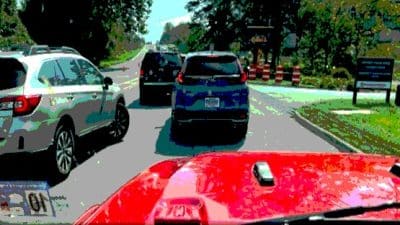
We woke up Sunday morning to a report that a bus-tractor trailer crash on Interstate 64 on Afton Mountain had sent multiple people to area hospitals with serious injuries.
Have to assume among the causes will be the freezing rain and drizzle that we also woke up to.
Which somehow wasn’t forecast ahead of time.
The National Weather Service didn’t send a Winter Weather Advisory out until 6:46 a.m., more than two hours after the 4:37 a.m. accident at Mile 100 on Interstate 64.
A look at the National Weather Service Twitter feed shows that the forecast for the overnight hours was: “Cold tonight. Clouds will increase, but it will remain dry.”
Early Sunday morning just down the mountain in Waynesboro, anyway, it was anything but dry. Roads, sidewalks, porches, all covered by a thin veneer of ice, the kind that can be more dangerous, because you can’t really see it, and if you’re not expecting it, even worse.
This is a reminder as to why it’s important that we don’t follow the dictates of the dopes in the Trump Administration who want to slash funding for the National Weather Service, because politics.
At last report, there were more than 400 jobs in the Weather Service left unfilled, after the administration proposed in each of its budgets to date to cut a similar number of jobs from the agency.
Coincidence, sure.
Has nothing to do with how the president is trying to appoint the former CEO of AccuWeather to head up NOAA, the agency whose oversight includes the Weather Service, and how that guy has advocated for making it possible for the AccuWeathers of the world to better monetize weather data, which, if you read between the lines, would have to involve putting more of that data behind pay walls, because how else do you monetize something that as of now is available to the public for free?
Thing is, somebody has to do the ground work to give the AccuWeathers and Weather Bugs and Weather Channels and your local TV meteorologists the information they use to craft the forecasts that they dream of being able to monetize.
Which is to say, the forecasts don’t just pop up out of the thin damn air.
Nope, it’s not all about having somebody tell you with a smile that it’s going to be sunny and 75 tomorrow, so make sure to pack some sunscreen.
People – trained people – have to synthesize and analyze reams of information to be able to tell us if it’s going to be 75, or if the mountain is going to be covered in a sheen of freezing drizzle.
And indeed, sometimes, a lot of times, a weather forecast is the reason drivers know there might be bad weather in the direction they’re traveling that they might need to take into account.
At locations like on our Afton Mountain, that can be crucial. The mountain isn’t all that significant in terms of its geography – with an elevation of just 1,903 feet – but its reputation as a treacherous stretch of road far outpaces the numbers.
Local legend has stories dating back to the 1920s, long before there was anything called an interstate, bemoaning the “pea soup” that slowed traffic on Route 250 in heavy fog.
The construction of the interstate facilitated travel between Charlottesville and the Shenandoah Valley, having the effect of increasing traffic counts and “pea soup” days.
The first multi-vehicle accident on the stretch of I-64 crossing Afton Mountain came just a week and a half after the December 1972 dedication ceremonies, which were themselves cut short due to high wind and fog.
Fast forward 20 years, to April 1992, and I almost got caught up in an Afton Mountain crash that made national headlines.
Driving back to UVA from Easter break early on a Monday morning, after deciding that the thick fog that had enveloped the area the night before was not worth testing, I missed by maybe 10 minutes the pair of chain-reaction accidents that ultimately involved 54 vehicles and claimed two lives.
The fog was so thick all the way to Charlottesville that I remember missing my exit and driving for several more miles before realizing the mistake and turning back.
I had no idea that there’d been a massive accident behind me, only being made aware of what had happened when I got back to my apartment that evening, to find out that family members had been calling all day to try to find me and make sure I hadn’t gotten caught up in the mess, in that era before cell phones.
I had no choice that morning but to drive over, and I knew what I was driving into, but with 30 years experience driving over Afton Mountain, I’ve come to develop a healthy respect (read: “fear”) of the “pea soup,” as I’m sure many locals on both sides of the hill have rooted in their DNA.
I wonder if non-locals have that appreciation. The topography on both sides can lull one to a false sense of security.
It’s not always a “pea soup” on the climb up the mountain, usually only getting to be a problem between Mile 98 and Mile 101, where things can go from cloudy to can’t see an inch past my windshield in the matter of a few seconds.
I’d speculate here if there’s a way to engineer some sort of warning system with variable message boards connected to up-to-the-minute weather data that could reduce speed limits to appropriate levels given conditions.
Locals know to slow down even ahead of the “pea soup” because they know it is up ahead. If you’ve never encountered it because you’re just passing through, it can be a shock to go from traveling at 70 mph or greater and almost instantaneously not be able to see more than a couple of free in front of your headlights.
This is probably something for VDOT to look at sooner rather than later.
And in the meantime, Congress needs to continue to press the Trump Administration on its slow-walk strangulation of the National Weather Service.
Weather forecasts aren’t something to be monetized. They can be matters of life and death.
Story by Chris Graham










